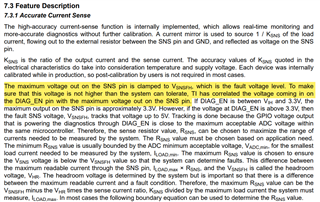Other Parts Discussed in Thread: TPS1HTC30-Q1
Tool/software:
Hello Team,
I am using the TPS1HTC100 ic for controlling the auxilary power. I am going with a max load of 5.7A, my Rlim would be 8Kohms. And to avoid saturation at my 3.3V microcontroller i am going with a Vsns(max = @5.7A) = 3.1V. So then the load current is 5.7A the Vsns would be 3.1V, my Rsns = 435ohms. but what is there is a short circuit and the current exceeds that ? will the output voltage on the sns pin go above the intended 3.1V and if yes then how can i protect the microcontroller that can take a maximum of 3.3V on its input pins ?
Thanks,
Karthik




